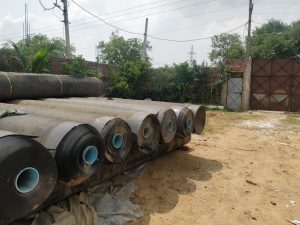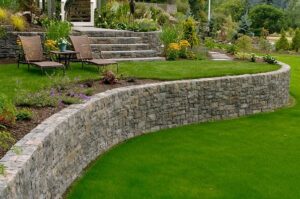How Geomembranes Help Stabilize Earth?

Geomembranes are synthetic membrane liners or barriers that are used to manage fluid flow in a man-made structure, system, or project. They’re created from thin, continuous polymeric sheets that are occasionally made by soaking geotextiles in asphalt, elastomer, or polymer sprays. As a result, their geotechnical engineering and other industrial client applications are limitless.
Geomembranes are utilized in the garbage sector, as well as in environmental, hydraulic, transportation, and oil and gas applications. Continuous polymeric sheets are the most prevalent form. For further strength and longevity, bigger geomembranes are thermally or chemically welded together at the seams. The geomembrane’s size is adjustable, so it may be as tiny as a home fish pond or as huge as a football field if needed.
Table of Contents
The geomembranes are impermeable geosynthetic materials used as liners in various environmental and civil engineering applications, such as landfills, ponds, and reservoirs, to prevent the seepage of liquids and gasses. They are usually made of high-density polyethene (HDPE), polyvinyl chloride (PVC), or ethylene propylene diene monomer (EPDM). They are selected based on their properties and suitability for the specific application.
In addition, a geomembrane liner is a synthetic membrane liner or barrier used to control fluid migration in a manmade project, structure, or system. They are made from relatively thin continuous polymeric sheets that are sometimes made from the infusion of geotextiles with asphalt, elastomer, or polymer sprays. Both geomembrane and or synthetic liners help to stabilize the earth and minimize fluid leakage after any civil engineering or environmental projects.
Top 5 Ways In Which Geomembranes Help Stabilize Earth
Geomembrane or geomembrane liner help stabilize the earth in many ways during or after the completion of any man-project that has a chance of fluid migration. Geomembranes can help stabilize the earth by providing an impermeable barrier to prevent the seepage of liquids and gasses, leading to erosion, contamination, and soil instability.
By acting as a liner, geomembranes can protect the underlying soil and prevent the leaching of pollutants into the surrounding environment. This can help to stabilize the earth by reducing the risk of erosion and the potential for soil contamination, which can lead to structural failure and instability of the land.
Additionally, the use of a geomembrane liner in conjunction with other geosynthetics, such as geotextiles and geogrids, can further enhance the stability and performance of the soil in various applications. To elaborate on the above statement, here are the top 5 ways in which these liners help stabilize the earth:
- Containment of hazardous materials: Geomembrane synthetic liners can provide an impermeable barrier to contain hazardous waste, preventing it from leaching into the soil and contaminating the surrounding environment.
- Erosion control: Geomembranes can help prevent soil erosion by protecting the underlying soil from the effects of water flow and wave action.
- Seepage prevention: A geomembrane can prevent the seepage of liquids and gasses, which can cause soil instability and other environmental problems.
- Water management: The geomembrane liner can be used in ponds, reservoirs, and other water management applications to prevent leakage and maintain water levels.
- Structural reinforcement: Geomembrane or HDPE membrane can be used in combination with other geosynthetics, such as geotextiles and geogrids, to provide structural reinforcement and stability to the soil.
Get Top Quality Geomembranes From Ocean Global!
As India’s leading supplier of environmentally friendly engineering solutions, Ocean Global is one of the finest geomembrane manufacturers in the industry. We offer cutting-edge geosynthetic and engineering solutions for soil-related issues on building sites. Our high-class geomembranes withstand extreme conditions and are used primarily for containing hazardous wastes, securing landfills, storing water, and preventing liquid pollution. In addition, we also produce versatile HDPE geomembranes that are simple to use, long-lasting, and aquatically safe.
Is Geomembrane and HDPE Membrane The Same?
Yes, HDPE membrane and geomembrane are the same. The only difference between these two is that HDPE membrane is a type of geomembrane made of high-density polyethene (HDPE) resin.
HDPE membranes are widely used in civil engineering projects to provide an impermeable barrier and help prevent the seepage of liquids and gasses. Here are a few ways in which these help in civil engineering projects:
- Environmental protection: HDPE liners are commonly used as liners in landfills, ponds, and reservoirs to prevent the leaching of hazardous materials into the surrounding environment.
- Water management: HDPE can be used in water management applications, such as canals, irrigation ditches, and reservoirs, to prevent leakage and maintain water levels.
- Geotechnical engineering: HDPE geomembrane can be used to stabilize soil and prevent erosion in slopes, retaining walls, and other geotechnical structures.
- Building foundations: These can be used as waterproofing membranes in building foundations to prevent water intrusion and protect against moisture damage.
- Infrastructure protection: These membranes can be used to protect infrastructure, such as bridges and tunnels, from the effects of water infiltration and soil instability.
Top Geomembrane Manufacturers and Suppliers in India
Ocean Global was founded in 1998 in New Delhi and is India’s leading supplier of environmentally friendly engineering solutions. Ocean Global is known for its ground-breaking geosynthetic and engineering solutions that address a variety of soil-related issues on building sites.
Ocean Global creates environmentally friendly and innovative geosynthetic membranes, often known as geomembranes, that operate well under extreme situations. Geomembranes are primarily used to confine hazardous wastes, support the soil, secure landfills, store water, and avoid liquid pollution.
Ocean Global, based in India, produces extremely flexible HDPE geomembranes that are simple to work with, have a long lifespan, and are, most importantly, aquatic safe. Their liquid-tight geomembranes meet and surpass the toughest liquid-containment requirements. Their Geomembrane coverings are high-performance membranes with a long lifespan. UV radiation, oxidation, and other weather impacts are not a problem for waterproof geomembranes.
FAQs
Where is the HDPE geomembrane commonly used?
They are commonly used in construction, environmental, and civil engineering applications for their durability and resistance to chemicals, UV radiation, and punctures.
What are the specifications of a geomembrane?
A geomembrane range in thickness from 0.5mm to over 2mm, with width typically ranging from 5 to 10 meters; they are made from different materials such as HDPE, LDPE, PVC, EPDM, and others.
What is the full form of the HDPE geomembrane?
The full form of HDPE geomembrane is High-Density Polyethylene Geomembrane.
Where is the geosynthetic liner most used?
These geo liners are most commonly used in line landfills, hazardous waste sites, ponds, reservoirs, canals, etc.
Are geosynthetic materials safe to use in civil projects?
Geosynthetic materials are safe to use in civil projects, provided they are installed correctly and in accordance with industry standards and guidelines.



